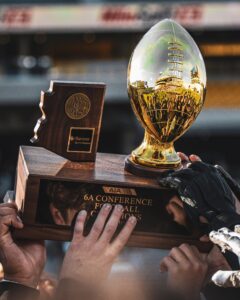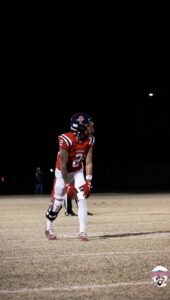- Slug: Sports-Arizona High School Transfers, 1,110 words.
- 2 photos available.
By Sebastian Mondaca Sepulveda
Cronkite News
PHOENIX – Some high school athletes are chasing a trophy. Some might want to pad their statistics for college scouts, while others hope a change in scenery could help them land a lucrative NIL deal.
Then there are the athletes who, through no fault of their own, must switch high schools because of family dynamics or hardship.
No matter the reason, transfers between Arizona high school sports teams have become more of a trend throughout the years. And with athletes looking for better opportunities, these transfers continue to reshape and redefine the culture of the sport.
Football, specifically, has generated spirited conversation among the transfers happening throughout the Valley. Big programs in the 6A and 5A regions benefit from transfers, which can create a sense of unfairness within the sport.
Much of the conversation this season has revolved around the Saguaro Sabercats, who had around 20 players transfer to different schools despite the team winning the 6A title in 2023. The motives of these transfers varied, with some players taking the risk in the hopes of better playing opportunities that might lead to a potential scholarship.
The transfers also took their toll, as Saguaro finished this season with a 1-9 record.
“Lots of transfers from one school is atypical,” Arizona Interscholastic Association director Jim Dean said. “The use of social media has been a big part for these students to transfer. Many of these colleges look at films to find you. There was a time when AIA bylaws where students would be ineligible … to play the entire year. They changed it for the half of the season.
“Transfer was happening back since 1982. It’s been going on for decades. Open enrollment is respected. Transfer, unironically, has gone down this year. Five years, this has been the lowest, but it still happens.”
Open enrollment became the norm in Arizona in 1994, allowing students to enroll in schools outside their district. The AIA has created a variety of rules to prevent transfers from getting out of control. The most recent, and fairly popular rule, stretches back to 2016, dictating that students who want to transfer to another high school must sit out the first half of the season before playing for their new team. Students may also apply for hardship for exceptions.
With the high school football playoffs set to commence Friday, this is the time that those transfers begin to make a difference for schools looking to repeat or win a state title.
Nikko Boncore-Montoya, who was a standout wide receiver at Glendale’s Cactus High, transferred to Centennial High in Peoria after the Coyotes made the Open Division championship game in 2023, with aspirations to help the team win the Open title this year.
However, because of the five-game transfer rule, Boncore-Montoya was ineligible to play for the majority of the season, which resulted in the team going 3-7 during the regular season and not qualifying for the Open Division. Despite this, Centennial still has the opportunity to win in the 6A region.
That begs the question if transfers are always beneficial for the students who have to sit out due to the rules. However, there’s no regret from Boncore-Montoya, who believes transferring has helped him become more than just an athlete.
“I don’t regret transferring at all,” Boncore-Montoya said. “Despite how the season has gone, I still believe we have an amazing chance to win that ring. These coaches have (made me better as a man) and to go on in life beyond football. They have also provided an environment that is like a college-like environment getting all of us ready for the next level … Transferring to Centennial has had a big impact on me.
“To all the other kids thinking about transferring, I say God has a plan for you and if you think transferring is your best opportunity to go where you want, then go for it. Really consider where the best fit for you and your family is and where you are welcome and go be great.”
Shawn Rustad, District Athletic Director for Chandler Unified School District, has seen the movement of transfers arise and understands the parents’ perspective on potential transfers, whether it affects the student academically or athletically.
“Ultimately, parents want their children to be in the best opportunity to be successful,” Rustad said. “When you’re in a metro area, one of the largest cities in the country, the state law allows for open enrollment. You want the children in their best situation. Whether that’s academics and athletics, you want them to succeed.
“I do think there’s been a growth of the East Valley that has been opening and has allowed many of these students to transfer to them. With that, you do see the number of transfers grow. For schools in the East Valley, it’s easy to transfer due to the growth. You look at the NIL and things trickle down on the sporting scenes.”
Name, image and likeness deals have started to infiltrate the high school scene as well. Although not fully immersive in comparison with the NCAA, it’s another option for athletes to consider when potentially transferring.
Many transfers will begin to find exposure from high-ranked schools to ensure they have the best opportunity for the spotlight. Since open enrollment is accessible for everyone, it’s not always easy for athletes who have lived in the same community to stay together to build a team.
Tommy Eubanks, Mesa Public School’s athletic director since 2021, explained how transfers have always been prevalent in Mesa and that he always considers the reasoning behind players transferring, but he prefers seeing athletes remain within the community.
“I’d like to see kids play for their communities and compete with one another,” Eubanks said. “There’s a big range from why students transfer. I’ve seen life-altering things to students and were forced to move. It’s a hardship rubric. Sometimes it’s students moving to school A to school B, and sometimes it doesn’t work out.
“The number of games you must sit out during the season, and it doesn’t add up. There’s been a decrease this year, but the trend is still very active. Not only for football, but a trend with all sports. Nonetheless, it’s still evolving, and I’m interested to see where it goes.”
There is still discussion about the trend of high school athletes transferring between schools in Arizona. Players are looking for better options, and communities are thinking about how this will affect team spirit and cohesion. The balance between personal goals and community loyalty will always be an important issue for schools, athletes and families, even as the rules change and more NIL possibilities open.
For more stories from Cronkite News, visit cronkitenews.azpbs.org.

